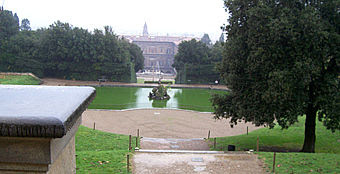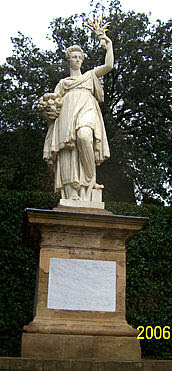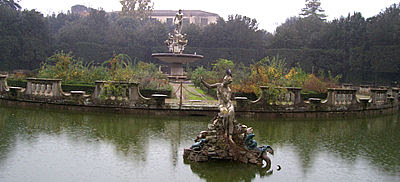Even though it was raining softly most of the time on that Tuesday 21 November 2006, we were determined to take a walk through the extensive Boboli Gardens behind the Palazzo Pitti.

Land on the hill called Boboli at the rear of the Palazzo Pitti was acquired in order to create a large formal park, the Boboli Gardens. The original design of the gardens centred on an amphitheatre, directly behind the main block of the palazzo, in which the classically-inspired plays of Florentine playwrights such as Giovan Battista Cini were performed for the amusement of the cultivated Medici court.
The Amphitheater was built by Giulio Parigi between 1630 and 1634. It was inaugurated in 1637 on the occasion of the coronation of Vittoria della Rovere, wife of Ferdinand II, as Grand Duchess of Tuscany. There are 24 statuary niches topping the seating area.
The Egyptian Obelisk in the amphitheatre has a fascinating history. It was originally erected in Heliopolis by Ramses II, who reigned from 1279 to 1212 BC. At some point it was transported to Rome and erected at the Temple of Isis. Sometime prior to the 17th century it was unearthed and moved to the Medici Villa in Rome. The Medici moved it to the Amphitheatre in 1790. In front of the obelisk is a granite tub designed by Pasquale Poccianti and placed there in 1840.

The Forcone Basin is considered by some to be the masterpiece of Zanobi del Rosso. The basin itself was built in 1777-78, while the terraces surrounding it are from the 17th century. This was originally a nursery for the gardens. The pond collects water from an aqueduct and the water is used to irrigate the gardens. In the middle of the pond is a bronze statue of Neptune by Stoldo Lorenzi, dating from 1571. This view is from the top of the Forcone Basin, throught the Amphitheatre to the back of the Palazzo Pitti.

Right at the top of the hill in line with the Amphitheatre and the Forcone Basin stands the statue "Abundance". It was started by Giambologna in 1608 and completed by Pietro Tacca and Sebastiano Salvini in 1636. It is sculpted of white marble, while the sheaf of wheat is made of bronze.
The statue has an interesting background. It was originally intended to be a representation of Johanna of Austria, wife of the Medici Grand-duke Francesco I, and it was supposed to be placed on a column in Piazza San Marco. It was transferred to the Gardens in 1636 to commemorate the prosperity of Tuscany.
Johanna was very short, so the story goes, and the courtiers referred to her as, "Her Shortness".

We were delighted to come across several Ginkgo biloba trees still showing beautiful yellow autumn leaves, although they were dropping fast. The Ginkgo is one of our personal favourites among trees, since it can be called a living fossil. It has no close living relatives.

On the way towards the Viottolone one passes through the "Prato dell'Uccellare" (Birding Field). This area signifies the beginning of the second phase of the development of the Gardens under Cosimo II (1609-1621). Before this time the Gardens ended here at a city wall erected during the war against Siena. From here we enjoyed a fine view overlooking Florence.

The father-and-son team of Giulio and Alfonso Parigi also established the Viottolone cypress alley and the Isolotto fountain. The Viottolone (Italian: large path) was intended as a carriage lane. Once you have walked from the Gardens entrance to the far end of the Viottolone you'll understand the need for wheels! The cypresses flanking the lane were planted in 1612.


Along the Viottolone one encounters various classically-themed statues, generally dated from the late 1500s and early 1600s.
Running parallel to the lane is the "Cerchiata", a long path with a kind of continuous awning formed by pruned holm oaks and dating from the Parigi renovations of 1612 to 1614.

The "Vasca dell'Isola" (Island Basin) contains the magnificent Isolotto at its centre, a small island full of citrus plants and roses. Rising above it all is the Fountain of the Ocean, executed in 1576 by Giambologna (also the creator of the Statue of Abundance). It was originally placed in the Amphitheater and relocated here in 1636.
The Ocean statue itself is an early 20th century copy of the original, which now resides at the Bargello museum. The smaller statue in the water is Andromeda by Giovan Battista Pieratti, made of white marble and bronze.


The Isolotto is at the far end of the gardens, so we had to find our way back to the Pitti Palace. On the way we passed some more delightful statues, like this terracotta dog, and the father and son making wine. The excitement of the winemaking clearly showed on the face of the young boy.

Closer to the palace we found this beautiful marble Pegasus. By then the afternoon was just about gone and we still had to walk all the way back to the hotel. You can believe we were two very tired, but satisfied, bunnies that night. What a wonderful conclusion to our stay in Florence!

1 comment:
Great blog! Thanks for the information.
Post a Comment